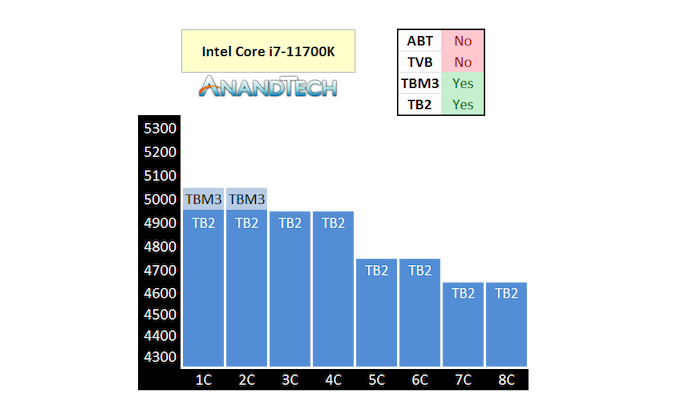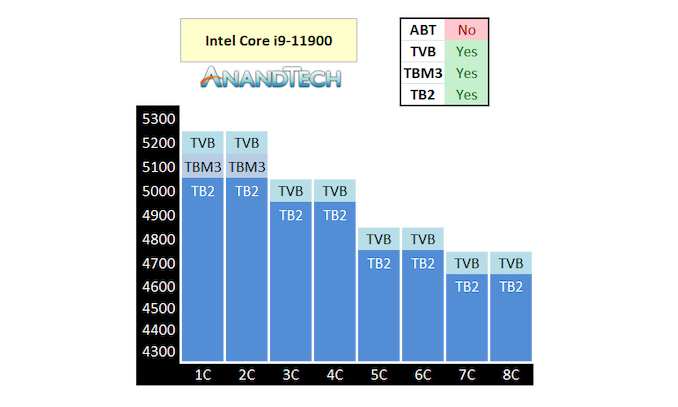Intel Rocket Lake (14nm) Review: Core i9-11900K, Core i7-11700K, and Core i5-11600K
by Dr. Ian Cutress on March 30, 2021 10:03 AM EST- Posted in
- CPUs
- Intel
- LGA1200
- 11th Gen
- Rocket Lake
- Z590
- B560
- Core i9-11900K
Intel’s New Adaptive Boost Technology for Core i9-K/KF
Taken from our news item
To say that Intel’s turbo levels are complicated to understand is somewhat of an understatement. Trying to teach the difference between the turbo levels to those new to measuring processor performance is an art form in of itself. But here’s our handy guide, taken from our article on the subject.
Adaptive Boost Technology is now the fifth frequency metric Intel uses on its high-end enthusiast grade processors, and another element in Intel’s ever complex ‘Turbo’ family of features. Here’s the list, in case we forget one:
| Intel Frequency Levels | ||
| Base Frequency | - | The frequency at which the processor is guaranteed to run under warranty conditions with a power consumption no higher than the TDP rating of the processor. |
| Turbo Boost 2.0 | TB2 | When in a turbo mode, this is the defined frequency the cores will run at. TB2 varies with how many cores are being used. |
| Turbo Boost Max 3.0 | TBM3 'Favored Core' |
When in a turbo mode, for the best cores on the processor (usually one or two), these will get extra frequency when they are the only cores in use. |
| Thermally Velocity Boost | TVB | When in a turbo mode, if the peak thermal temperature detected on the processor is below a given value (70ºC on desktops), then the whole processor will get a frequency boost of +100 MHz. This follows the TB2 frequency tables depending on core loading. |
| Adaptive Boost Technology | ABT 'floating turbo' |
When in a turbo mode, if 3 or more cores are active, the processor will attempt to provide the best frequency within the power budget, regardless of the TB2 frequency table. The limit of this frequency is given by TB2 in 2-core mode. ABT overrides TVB when 3 or more cores are active. |
| *Turbo mode is limited by the turbo power level (PL2) and timing (Tau) of the system. Intel offers recommended guidelines for this, but those guidelines can be overridden (and are routinely ignored) by motherboard manufacturers. Most gaming motherboards will implement an effective ‘infinite’ turbo mode. In this mode, the peak power observed will be the PL2 value. It is worth noting that the 70ºC requirement for TVB is also often ignored, and TVB will be applied whatever the temperature. | ||
Intel provided a slide trying to describe the new ABT, however the diagram is a bit of a mess and doesn’t explain it that well. Here’s the handy AnandTech version.
First up is the Core i7-11700K that AnandTech has already reviewed. This processor has TB2, TBM3, but not TVB or ABT.
The official specifications show that when one to four cores are loaded, when in turbo mode, it will boost to 4.9 GHz. If it is under two cores, the OS will shift the threads onto the favored cores and Turbo Boost Max 3.0 will kick in for 5.0 GHz. More than four core loading will be distributed as above.
On the Core i9-11900, the non-overclocking version, we also get Thermal Velocity Boost which adds another +100 MHz onto every core max turbo, but only if the processor is below 70ºC.
We can see here that the first two cores get both TBM3 (favored core) as well as TVB, which makes those two cores give a bigger jump. In this case, if all eight cores are loaded, the turbo is 4.6 GHz, unless the CPU is under 70ºC, then we get an all-core turbo of 4.7 GHz.
Now move up to the Core i9-11900K or Core i9-11900KF, which are the only two processors with the new floating turbo / Adaptive Boost Technology. Everything beyond two cores changes and TVB no longer applies.
Here we see what looks like a 5.1 GHz all-core turbo, from three cores to eight cores loaded. This is +300 MHz above TVB when all eight cores are loaded. But the reason why I’m calling this a floating turbo is because it is opportunistic.
What this means is that, if all 8 cores are loaded, TB2 means that it will run at 4.7 GHz. If there is power budget and thermal budget, it will attempt 4.8 GHz. If there is more power budget and thermal budget available, it will go to 4.9 GHz, then 5.0 GHz, then 5.1 GHz. The frequency will float as long as it has enough of those budgets to play with, and it will increase/decrease as necessary. This is important as different instructions cause different amounts of power draw and such.
If this sounds familiar, you are not wrong. AMD does the same thing, and they call it Precision Boost 2, and it was introduced in April 2018 with Zen+. AMD applies its floating turbo to all of its processors – Intel is currently limiting floating turbo to only the Core i9-K and Core i9-KF in Core 11th Gen Rocket Lake.
One of the things that we noticed with AMD however is that this floating turbo does increase power draw, especially with AVX/AVX2 workloads. Intel is likely going to see similar increases in power draw. What might be a small saving grace here is that Intel’s frequency jumps are still limited to full 100 MHz steps, whereas AMD can do it on the 25 MHz boundary. This means that Intel has to manage larger steps, and will likely only cross that boundary if it knows it can be maintained for a fixed amount of time. It will be interesting to see if Intel gives the user the ability to change those entry/exit points for Adaptive Boost Technology.
There will be some users who are already familiar with Multi-Core Enhancement / Multi-Core Turbo. This is a feature from some motherboard vendors have, and often enable at default, which lets a processor reach an all-core turbo equal to the single core turbo. That is somewhat similar to ABT, but that was more of a fixed frequency, whereas ABT is a floating turbo design. That being said, some motherboard vendors might still have Multi-Core Enhancement as part of their design anyway, bypassing ABT.
Overall, it’s a performance plus. It makes sense for the users that can also manage the thermals. AMD caught a wind with the feature when it moved to TSMC’s 7nm. I have a feeling that Intel will have to shift to a new manufacturing node to get the best out of ABT, and then we might see the feature on the more mainstream CPUs, as well as becoming default as standard.













279 Comments
View All Comments
Hulk - Tuesday, March 30, 2021 - link
I have also been looking for iGPU tests?It's strange. It's like it doesn't exist.
eastcoast_pete - Tuesday, March 30, 2021 - link
Predictable results. I don't believe Intel back-ported to 14 nm because their 10 nm couldn't reach high frequencies, they back-ported because their yields at 10 nm aren't high enough and they had manufacturing capacity available at 14 nm. That made the expense of back-porting the design worthwhile.Regarding Rocket Lake, the most interesting CPUs in this lineup are the non-K i5, especially the ones that still have the 32 EUs enabled. Any chance you (Ian) can put one or two 11500 or 11600 through their paces. I would really like to also see how "35 W" the T models are. One of those, plus a decent, WiFi-enabled 560 MoBo for $100-130 could serve HTPC and office duties.
Otritus - Tuesday, March 30, 2021 - link
Rocket lake is an 8 core cpu based on the cypress (sunny) cove microarchitecture. Tigerlake H is an 8 core cpu based on the willow (sunny+) cove microarchitecture. Both have 32 Xe EUs. 10SF and 10ESF yields well (Intel is shipping much larger server processors just fine). The problem is 10SF seems to max out around 5Ghz which is the upper bounds of the 11700K. The slight clock bump of the 11900K lets Intel claim the fastest gaming cpu, which would not have been possible on Tigerlake H. 14nm having excess capacity was simply the cherry on top.goatfajitas - Tuesday, March 30, 2021 - link
I dont th9ink anything Intel has done here can be called "cherry on top" if anything we will look on this as a hot mess (pun intended). :PAntonErtl - Wednesday, March 31, 2021 - link
Intel shipping larger chips in their current 10nm processes does not disprove yield problems. If there is a flaw in a core on a 40-core die, jut disable the core (and another one) and sell it as 38-core CPU. If there are flaws in three cores, sell it as 36-core CPU, etc. Of course that's also possible and done for Tiger Lake, but there is also parts of the CPU where you have no such redundancy, but the area for these parts is not necessarily larger for the bigger dies, and the huge price for the big dies may make it economically more viable there than on the desktop.What makes me believe that either 10nm yield or 10nm capacity is not so great (or capcity is not reat because yield is not great) is that the announced Xeon W-13xx CPUs are going to be Rocket, not Tiger Lake; at 80W TDP, I expect that Tiger Lake would outperform Rocket Lake for most multi-threaded and (thangs to larger cache) some single-threaded workloads, yet they give us Rocket Lake,
Spunjji - Friday, April 9, 2021 - link
Intel arriving nearly 3 years late with Ice Lake SP and only managing "over 200,000" in the first 3 months isn't "just fine", it's pretty indicative that they're still struggling.We have no indication of ESF yields yet as there are no ESF products shipping yet.
Rocket Lake was ported when Intel couldn't get clock speeds *or* yields out of their 10nm process. If their yields and capacity for 10SF were as good as you're implying, we wouldn't still be waiting for Tiger Lake H to actually hit the market so long after Tiger Lake launched.
YazX_ - Tuesday, March 30, 2021 - link
4 years ago, AMD was broke, fighting for survival, targeting the poor and intel was the top dog and spit the same s.hit for the 10 years, fast forward now, AMD is the top dog and intel cannot even catch up.Regarding the review, yah as usual s.hit intel CPU that draws alot of power and still priced higher than AMD while offering less.
haukionkannel - Tuesday, March 30, 2021 - link
And Intel will be selling these much, much more than amd can their own...Intel just need to exist, to win amd in market share...
Qasar - Tuesday, March 30, 2021 - link
haukionkannel yep, only because its on the shelf, if/when ryzen 5000 supply gets better expect that to change. once that happens intel wont be selling that well. no one i know is even looking at intel right now, all waiting for zen 3.SkyBill40 - Tuesday, March 30, 2021 - link
You mean Zen 4?